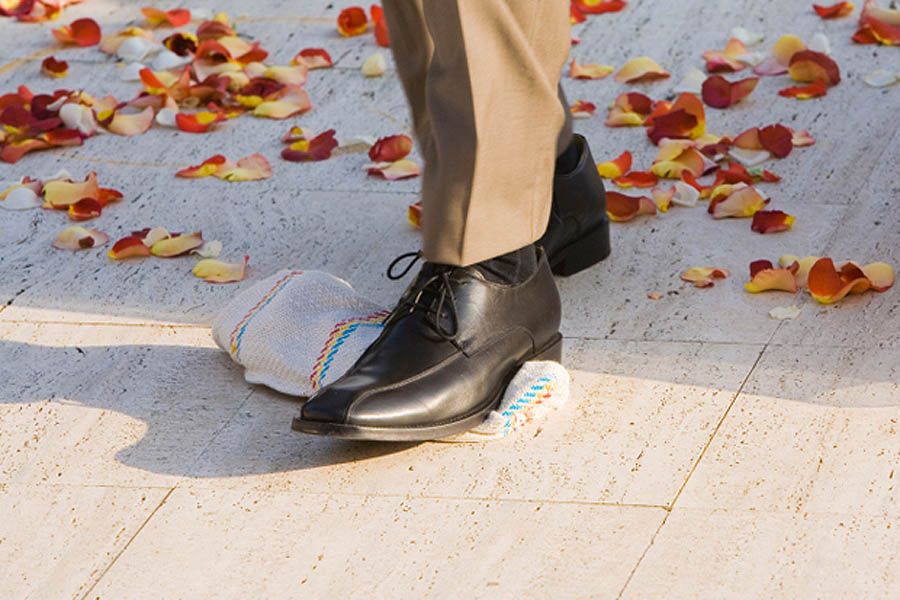Mazel Tov: A Guide to the Big Wedding Ceremony Moments

Though weddings include immense planning and detail, much of their significance comes from the simple beauty and meaning of traditions.
“Wedding traditions were born in an age when most could only read gestures, not texts, and so they were designed to signify the great mystery of marriage with a humble and direct simplicity,” says Michael P. Foley, author of “Wedding Rites: The Complete Guide to Traditional Vows, Music, Ceremonies, Blessings, and Interfaith Services” (Eerdmans, 2008). He adds that weddings are not only a hope for a happy future; they’re also a reminder of special people and memories. Traditions give couples a chance to reflect on and recognize their loved ones and their heritage.
“Modern couples are slowly rediscovering the refreshing value of traditions because they are coming to recognize how timeless and relevant they are,” Foley says. “Oftentimes what is cutting-edge one day is cliché the next. A truly traditional wedding stands out as something distinctive and memorable.”
Though each culture and faith has a plethora of wedding traditions, here are a few practices to keep an eye out for or think about incorporating.
Western Christianity Vows
In Western Christian theology, which includes Roman Catholics and Protestants, marriage is completed through mutual consent of the bride and groom. This is why the consent is given through a vow, Foley says – at that moment, the couple becomes husband and wife. He adds that the vows often take place early in the ceremony because the priest or minister witnesses and blesses what the couple has already created before him. The couple isn’t announced as husband and wife until the end of the ceremony to help create a more climactic conclusion to the event.
Eastern Orthodox Christianity
Unlike Western Christianity’s vows, Eastern Orthodox churches don’t share the same theology about marriage and thus have no vows in the ceremony. Instead, the couple becomes husband and wife when the priest places a crown on each of their heads. The crowns symbolize the creation of a new house. Consequently, in Greek a wedding is called “a crowning.”
Catholic Weddings
The Blessed Virgin Mary plays a large role in many Catholic traditions, and weddings are no exception. Sometimes in Catholic ceremonies, the bride alone or the bride and groom together will lay a bouquet of flowers at the foot of the statue of Mary as a token of their devotion and for Mary’s prayers to make their marriage fruitful. Rev. Susanna Stefanachi Macomb, author of “Joining Hands and Hearts: Interfaith, Intercultural Wedding Celebrations” (Simon & Schuster, 2002), adds that sometimes the bride carries two roses as she processes up the aisle – one to hand to her mother and one to place before the statue.
Jewish Weddings
Jewish weddings traditionally include breaking a glass at the end of the ceremony while everyone shouts “Mazel Tov!” The broken glass marks the end of the ceremony and the beginning of the festivities. According to Macomb, the ancient custom has several interpretations. Conservative synagogues say it represents the destruction of the Temple in Jerusalem, reminding the couple that the sweetest co-exists with sorrow. Macomb says her favorite modern interpretation is that it symbolizes a transformative experience, leaving the couple forever changed and forever united. “The glass is broken with the implied wish: May you stay together until all the broken pieces come back together,” she says.
Jewish receptions also include the horah: an Israeli folk dance also done at other celebratory occasions, such as bat and bar Mitzvahs. During the dance, guests honor the bride and groom by lifting them high in a chair, signifying the community’s support for the couple. The couple holds a white handkerchief between them to symbolize their new bond.
African-American Weddings
Though its beginnings are disputed, “jumping the broom” is a tradition some African-Americans still use to honor their ancestors and heritage. Many say the practice began when African-American slaves were prohibited to marry in the pre-Civil-War South (others say it began even earlier). “They invented their own custom to ratify the permanence of their love,” Foley says. At the end of the ceremony, the couple placed a broom on the floor, held hands and jumped over it together. “The symbolism was simple but beautiful,” he says. “The broom represented hearth and home, while the jump signified the transition to domestic union.”
Today couples can buy specialty brooms made specifically for the traditional practice. The jump can either occur at the end of the ceremony or at the reception.
Wedding traditions are as numerous and varied as all the world’s cultures. Author Susanna Stefanachi Macomb points out a few more:
Irish: Traditional Irish wedding blessing
Quaker: Tradition of silence
Jewish: Marrying under a chuppah
Persian: Having a “sofreh” (Persian marriage spread)
Hindu: Walking seven steps and circling a fire
Japanese: Having the san-san-kudo, the sake ceremony
Chinese: A reading from the I Ching, a classic Chinese text, and incorporating red for good luck
Muslim: Incorporating a “nikah” (Muslim marriage contract)
© Brides365